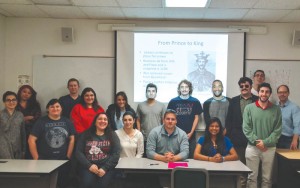
Photo: Aramayis Orkusyan
Michael Rettig
Staff Writer
History plays an important role in helping people understand their identity. It enables one to understand the experiences of their ancestors and how they have shaped our contemporary world. Students in Professor Sergio La Porta’s Armenian Studies108B course, a survey of modern Armenian history, have been able to better understand the present situation of the Armenian nation by learning about its history.
The course explores Armenian history from the year 1000AD and includes the Turkic invasions up to the present day dispersion of Armenians and the creation of the Republic of Armenia.
“I think that the time period covered in this class is important because it helps us understand current events and conflicts in Armenia and the surrounding areas,” said student Lauren Chardukian.
Students expressed an excitement to learn about the Armenian culture in greater depth. “I moved here when I was young and I didn’t get the chance to learn all of these things when I was in Lebanon. I only had a very basic knowledge of Armenian history and I like this class because we’re able to go in depth,” said Haverj Stanboulian.
The class is composed of both Armenian and non-Armenian students, many of whom were History majors taking the course to fulfill a World Regions requirement in their degree. This enables the class to reach a diverse audience.
“I think it’s great for young Armenians and non-Armenians to understand how rich of a culture we have,” stated Menas Arisian.
Professor La Porta’s goal for the class is to foster a better understanding of Armenia’s current state. “I’d like to give them the sense of the general arc of Armenian history. The trajectories in this course in particular are to talk about what caused the Armenian dispersion as well as the formation of Armenian national identity, the goals of establishing an Armenian state, and then its eventual establishment.”
He hopes to accomplish this while tying the Armenian narrative into a greater world context. “One of the challenges of Armenian history is that it doesn’t occur in isolation. I try to approach it from the position of world history.”
Professor La Porta explained that the various Armenian states and Diasporas heavily interacted with various cultures, states, and empires across a large geographical scale. This enables him to touch upon broader world events, such as the Crusades, from a different perspective.
“The Armenian case gives a particular look at what happened in the world, not necessarily from the viewpoint of the dominant culture, but of a significant contributor to that culture.”
Students are able to learn not only about Armenian history, but also about various other groups and how they interacted with Armenians.
The course helps students to understand the current friendships or animosities between these groups in the present day Middle East.
 Hye Sharzhoom Armenian Action
Hye Sharzhoom Armenian Action